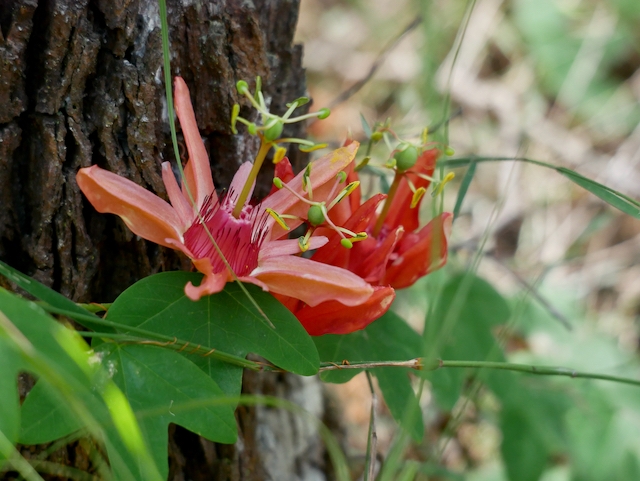Orange-Petaled Passion Flower
(Passiflora aurantia)
Orange-Petaled Passion Flower (Passiflora aurantia)
/
/

Karin Cox
CC BY 4.0
Image By:
Karin Cox
Recorded By:
Copyright:
CC BY 4.0
Copyright Notice:
Photo by: Karin Cox | License Type: CC BY 4.0 | License URL: http://creativecommons.org/licenses/by/4.0/ | Rights Holder: Karin Cox | Publisher: iNaturalist | Date Created: 2022-12-11T02:20:22-08:00 |























Estimated Native Range
Summary
Passiflora aurantia, commonly known as the orange-petaled passion flower, is a perennial vine native to rainforests and sheltered areas within subtropical and tropical regions of New Caledonia and Australia. It is a fast-growing plant that can reach lengths of several meters. The vine is evergreen in areas free from frost and can be semi-deciduous in cooler regions. It produces distinctive flowers with bright orange petals and a central crown of purple and white filaments, which bloom intermittently throughout the year, with peak flowering in summer. The flowers are moderately showy and attract pollinators such as bees and butterflies.
The orange-petaled passion flower is valued for its ornamental flowers and its ability to quickly cover structures such as trellises and fences, making it a popular choice for tropical and subtropical gardens. It requires well-drained soil, regular watering, and thrives in full sun to part shade. While the fruit is edible, it is not widely cultivated for consumption due to its lackluster taste. In cultivation, it is relatively low maintenance but may require pruning to control its vigorous growth. It is susceptible to pests such as aphids and caterpillars, which can be managed with appropriate horticultural practices. This species is not known for being invasive outside its native range.CC BY-SA 4.0
The orange-petaled passion flower is valued for its ornamental flowers and its ability to quickly cover structures such as trellises and fences, making it a popular choice for tropical and subtropical gardens. It requires well-drained soil, regular watering, and thrives in full sun to part shade. While the fruit is edible, it is not widely cultivated for consumption due to its lackluster taste. In cultivation, it is relatively low maintenance but may require pruning to control its vigorous growth. It is susceptible to pests such as aphids and caterpillars, which can be managed with appropriate horticultural practices. This species is not known for being invasive outside its native range.CC BY-SA 4.0
Plant Description
- Plant Type: Vine
- Height: 15-22 feet
- Width: 2-22 feet
- Growth Rate: Moderate
- Flower Color: Red
- Flowering Season: Spring, Summer, Fall
- Leaf Retention: Deciduous
Growth Requirements
- Sun: Full Sun, Part Shade
- Water: Medium
- Drainage: Medium
Common Uses
Bee Garden, Butterfly Garden, Showy Flowers
Natural Habitat
Native to rainforests and sheltered areas within subtropical and tropical regions of New Caledonia and Australia
Other Names
Common Names: Orange Passionvine, Scarlet Passionflower
Scientific Names: , Passiflora aurantia, Blephistelma aurantia, Disemma adiantifolia, Disemma adiantifolium, Disemma aurantia, Disemma aurantiaca, Disemma banksii, Disemma baueri, Disemma baueriana
GBIF Accepted Name: